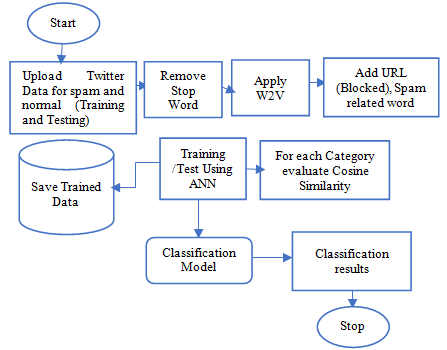Enhanced Spam Detection System for Twitter Social Networking Platform
Main Article Content
Abstract
Twitter social site is one of the most popular Online Social Networking Site (OSN) used by popular people such as Ministers, businessman, large companies, actors to share their information. In this site, around 500 million of tweets are posted monthly by the total 313 million Twitter active users. The widespread of Twitter has drawn the interest of spammers. These malicious actors exploit the platform for various nefarious purposes, including monitoring authentic users, disseminating harmful software, and promoting their agendas through URLs embedded in tweets. They engage in tactics like secret following and unfollowing legitimate users, all with the intent of gathering sensitive information.To resolve this problem, a secure spam detection based on machine learning approach is designed. The designed used stop word removal, word to vector model to refined and dimensionally reduced the data. To enhance the quality of the data Cosine similarity is also been applied to measure the similarity score among the tweets and based upon that Artificial Neural Network (ANN) is trained. Later on, it is used to test the efficiency by examining the performance parameters in terms of precision, recall and F-measure. Also, the comparative analysis has been performed to present the efficiency of the work. The average precision, recall and F measure of proposed spam detection model of 0.9252, 0.6107 and 0.734 are obtained.
Article Details
References
N. Kundu, and Y.K. Meena, “Detecting Suspicious Users in Social Networks Using Text Analysis,” In Smart Systems and IoT: Innovations in Computing, Springer, Singapore, pp. 463-473, 2020.
T. Satija, and N.Kar, “Detecting Malicious Twitter Bots Using Machine Learning,” In International Conference on Computational Intelligence, Security and Internet of Things, Springer, Singapore, pp. 182-194, December 2019.
A. T. Kabakus, and R.Kara, “TwitterSpamDetector: A Spam Detection Framework for Twitter,” International Journal of Knowledge and Systems Science (IJKSS), vol.10, no.3, pp. 1-14, 2019.
R. Paudel, P. Kandel, and W. Eberle, “Detecting Spam Tweets in Trending Topics Using Graph-Based Approach,” In Proceedings of the Future Technologies Conference, Springer, Cham, pp. 526-546, October 2019.
Chaudhary, D. S. . (2021). ECG Signal Analysis for Myocardial Disease Prediction by Classification with Feature Extraction Machine Learning Architectures. Research Journal of Computer Systems and Engineering, 2(1), 06:10. Retrieved from https://technicaljournals.org/RJCSE/index.php/journal/article/view/12.
V. Mardi, A. Kini, V. M. Sukanya, and S. Rachana, “Text-Based Spam Tweets Detection Using Neural Networks,” In Advances in Computing and Intelligent Systems, Springer, Singapore, pp. 401-408, 2020.
H. Tajalizadeh, and R. Boostani, “A novel stream clustering framework for spam detection in twitter,” IEEE Transactions on Computational Social Systems, vol. 6, no. 3, pp. 525-534, 2019.
C. Yang, R. Harkreader, and G. Gu, “Empirical evaluation and new design for fighting evolving twitter spammers,” IEEE Transactions on Information Forensics and Security, vol. 8, no. 8, pp. 1280-1293, 2013.
C. Chen, J. Zhang, Y. Xiang, and W. Zhou, “Asymmetric self-learning for tackling twitter spam drift,” In 2015 IEEE Conference on Computer Communications Workshops (INFOCOM WKSHPS), IEEE, pp. 208-213, April 2015.
B. Wang, A. Zubiaga, M. Liakata, and R. Procter, “Making the most of tweet-inherent features for social spam detection on Twitter,” arXiv preprint arXiv, vol.1503, pp. 07405, 2015.
G. Stringhini, C. Kruegel, and G. Vigna, “Detecting spammers on social networks,” In Proceedings of the 26th annual computer security applications conference, pp. 1-9, December 2010.
J. Song, S. Lee, and J. Kim, “Spam filtering in Twitter using sender receiver relationship,” in Proc. 14th Int. Conf. Recent Adv. Intrusion Detect., pp. 301–317, 2011.
Lee, B.-K. . (2023). A Study on Image Quality Improvement for 3D Pagoda Restoration. International Journal of Intelligent Systems and Applications in Engineering, 11(4s), 150–156. Retrieved from https://ijisae.org/index.php/IJISAE/article/view/2582
C. Yang, R. Harkreader, and G. Gu, “Empirical evaluation and new design for fighting evolving Twitter spammers,” IEEE Trans. Inf. Forensics Sec., vol. 8, no. 8, pp. 1280–1293, Aug. 2013.
K. Thomas, C. Grier, J. Ma, V. Paxson, and D. Song, “Design and evaluation of a real-time url spam filtering service,” In 2011 IEEE symposium on security and privacy, IEEE , pp. 447-462, May 2011.
M. Al-Janabi, E. D. Quincey, and P. Andras, “Using supervised machine learning algorithms to detect suspicious URLs in online social networks,” In Proceedings of the 2017 IEEE/ACM International Conference on Advances in Social Networks Analysis and Mining 2017, pp. 1104-1111, July 2017.
N. S. Murugan, and G. U. Devi, “Detecting streaming of Twitter spam using hybrid method,” Wireless Personal Communications, vol. 103, no. 2, pp. 1353-1374, 2018.
K. S. Reddy and E. S. Reddy, “Using Reduced Set of Features to Detect Spam in Twitter Data with Decision Tree and KNN Classifier Algorithms,” International Journal of Innovative Technology and Exploring Engineering (IJITEE), vol. 8, no. 9, pp. 6-12, 2019.
A. Begum, and S. Badugu, “A Study of Malicious URL Detection Using Machine Learning and Heuristic Approaches,” In Advances in Decision Sciences, Image Processing, Security and Computer Vision, Springer, Cham, pp. 587-597, 2020.

